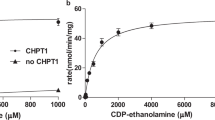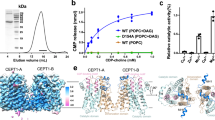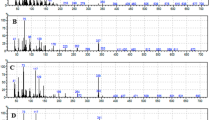Abstract
CARNITINE can replace the dietary choline, otherwise essential, when Phormia regina larvae are reared on a chemically defined diet1,2. When this substitution is made, β-methyl-choline almost completely replaces choline in the lecithin of the larva3,4. Similar results have been obtained with the house fly, Musca domestica Linnaeus5. γ-Butyrobetaine can also substitute for choline in the diet2, giving rise to phosphatidyl β-methylcholine6. Recent investigations by Hodgson and Dauterman7 have demonstrated that trimethyl-(3-hydroxypropyl) ammonium acetate (TMAA) inhibits the growth of P. regina larvae when the choline of the diet is replaced by carnitine or γ-butyrobetaine but does not when choline is present. Thus, it would appear to inhibit one of the metabolic reactions between carnitine or γ-butyrobetaine and the β-methylcholine moiety of phosphatidyl β-methylcholine.
This is a preview of subscription content, access via your institution
Access options
Subscribe to this journal
Receive 51 print issues and online access
$199.00 per year
only $3.90 per issue
Buy this article
- Purchase on Springer Link
- Instant access to full article PDF
Prices may be subject to local taxes which are calculated during checkout
Similar content being viewed by others
References
Hodgson, E., Cheldelin, V. H., and Newburgh, R. W., Canad. J. Zool., 34, 527 (1956).
Hodgson, E., Cheldelin, V. H., and Newburgh, R. W., Arch. Biochem. Biophys., 87, 48 (1960).
Bieber, L. L., Cheldelin, V. H., and Newburgh, R. W., Biochem. Biophys. Res. Commun., 6, 237 (1961).
Bieber, L. L., Cheldelin, V. H., and Newburgh, R. W., J. Biol. Chem., 238, 1262 (1963).
Bridges, R. G., Ricketts, J., and Cox, J. T., J. Inst. Physiol., 11, 225 (1965).
Agarwal, H. C., and Houx, N. W. H., Biochim. Biophys. Acta, 84, 353 (1964).
Hodgson, E., and Dauterman, W. C., J. Inst. Physiol., 10, 1005 (1964).
Mazzetti, F., and Lemmon, R. M., J. Org. Chem., 22, 228 (1957).
McGinnis, A. J., Newburgh, R. W., and Cheldelin, V. H., J. Nutrit., 58, 309 (1956).
Bieber, L. L., Hodgson, E., Cheldelin, V. H., Brooks, V. J., and Newburgh, R. W., J. Biol. Chem., 236, 2990 (1961).
Rouser, G., Kritchevsky, G., Dorothy, H., and Helen, L., J. Amer. Oil Chemists Soc., 40, 425 (1963).
Bremer, J., J. Biol. Chem., 237, 3628 (1962).
Bieber, L. L., and Newburgh, R. W., J. Lipid Res., 4, 397 (1963).
Author information
Authors and Affiliations
Rights and permissions
About this article
Cite this article
MEHENDALE, H., DAUTERMAN, W. & HODGSON, E. Phosphatidyl Carnitine: a Possible Intermediate in the Biosynthesis of Phosphatidyl β-Methylcholine in Phormia regina (Meigen). Nature 211, 759–761 (1966). https://doi.org/10.1038/211759b0
Issue Date:
DOI: https://doi.org/10.1038/211759b0
Comments
By submitting a comment you agree to abide by our Terms and Community Guidelines. If you find something abusive or that does not comply with our terms or guidelines please flag it as inappropriate.



